Rapid Data Rapidman 1208LC,
Sears C1 and Sears M12
In 1972 North American Rockwell Microelectronics Inc. became the first company to manufacture calculators with Liquid Crystal Displays.
Rockwell produced several models of similar calculators using DSM (Dynamic Scattering Mode) LCDs (Liquid Crystal Displays) for sale by a handful of companies. A DSM LCD is clear until a voltage is applied when it becomes opaque white. By energising transparent electrodes on the LCD glass, in the familiar 7-segment configuration, numbers can be displayed.
Here are a three of the desktop models with Rockwell LCDs:
Similar calculators appeared under the Lloyds label, and hand-held versions were also produced such as the Lloyds Accumatic 100.
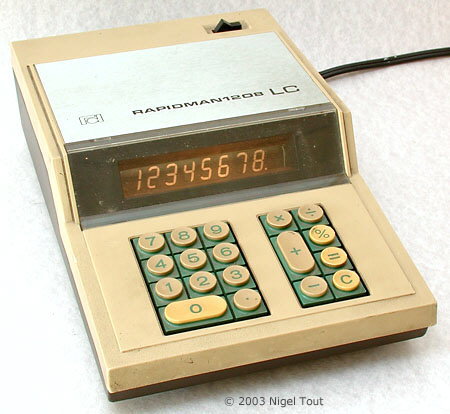
Rapid Data Rapidman 1208LC
Distinctive features: One of the first calculators with a Liquid Crystal Display (LCD), using a DSM (Dynamic Scattering Mode) LCD.
Technical details:
Display is 8 digits, reflective Liquid Crystal Display (LCD), which is illuminated by a filament lamp.
4 function, %.
The circuit board carries 3 Large-scale integrated circuits manufactured by Rockwell (two type 10417PB and a 15311P), and in the machine ilustrated are date coded to early-1973.
165 x 276 x 80mm / 6.5x10.9x3.1".
Rapid Data Systems & Equipment Ltd., of Ontario.Canada.
Assembled in Mexico primarily of United States parts.
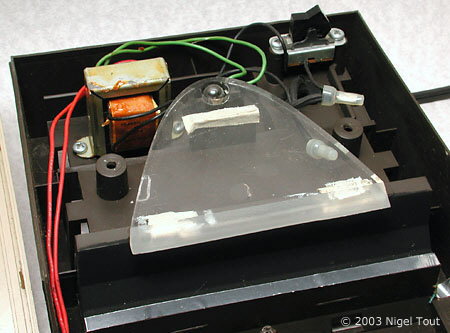
The cover has been removed to show the half-elliptical plastic light guide which projects light at a glancing angle across the LCD. The filament lamp is at the rounded end of the light guide.
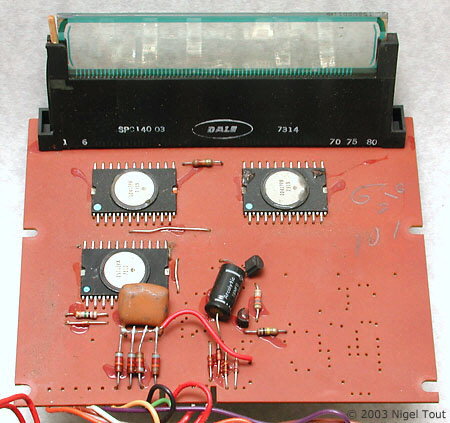
The circuit board with the three Rockwell integrated circuits and the LCD.
The LCD is clear when unenergised and in the calculator is mounted against a black background. When segments of a digit
are energised they turn shiny metallic, unlike modern LCDs which turn black.
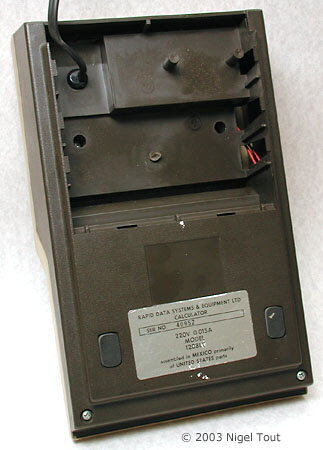
The rear of the calculator with a cover slid off to reveal a large space which could be used to hold batteries in a hand-held version.
Compare this machine with the Lloyds Accumatic 100, which is a slightly smaller hand-held version.
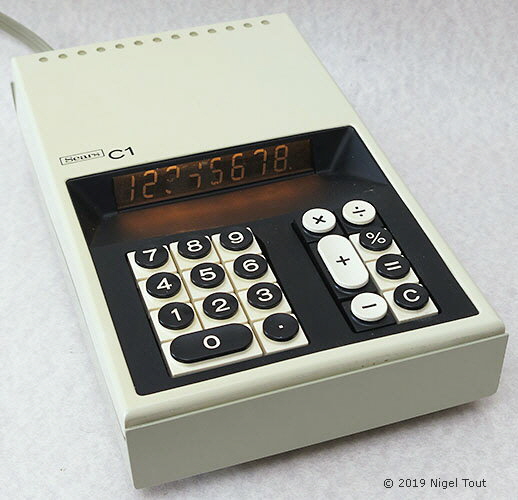
Sears C1
Distinctive features: One of the first calculators with a Liquid Crystal Display (LCD), using a DSM (Dynamic Scattering Mode) LCD.
Technical details: Display is 8 digits, reflective LCD (Liquid Crystal Display), which is illuminated by a filament lamp. In this example a couple of digits towards the left of the display are damaged.
4 function, %.
The circuit board in this model carries 3 Large-scale integrated circuits manufactured by Rockwell (two type 10417PB and a 15311PA), and in the machine illustrated are date coded early to mid-1973.
Sears, Roebuck & CO., Chicago, Ill, U.S.A.
Assembled in Mexico.
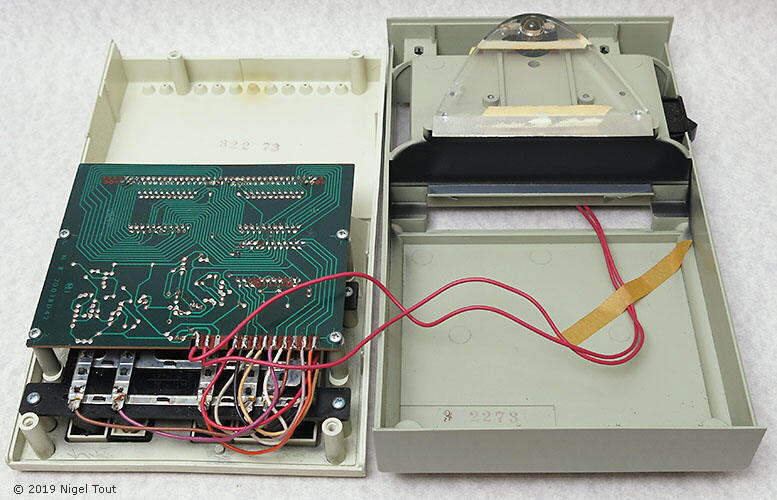
Here the casing has been opened. The top with the keypad and circuit board with the LCD display is on the left. The bottom has the clear plastic parabolic light-guide which guides the light from the filament lamp in the hole at the focus at the far end to the top edge of the display which will be located in front of the black surface.
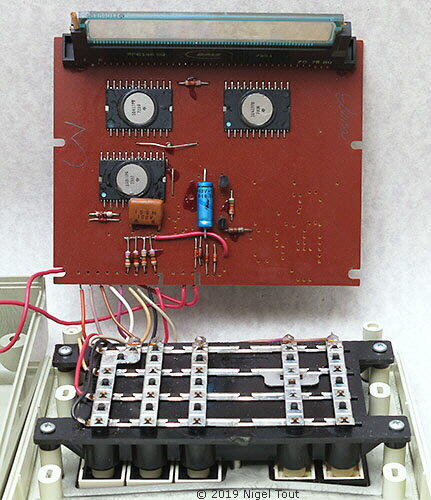
The circuit board with the LCD display and three Rockwell integrated circuits has been removed from the keyboard assembly.
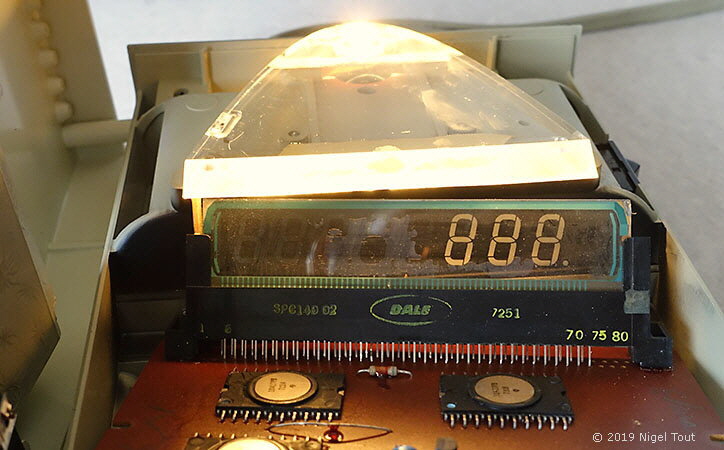
To give a better view of how the LCD display in these models operates the circuit board has been placed in the opened calculator so that the display is under the light guide and in front of the black surface and the power has been turned on. The light is projected onto the top edge of the display by the angle formed at the front of the light guide. The light is scattered from the digits '888' that have been keyed in and have voltage applied, whereas the rest of the display with no applied voltage is clear.
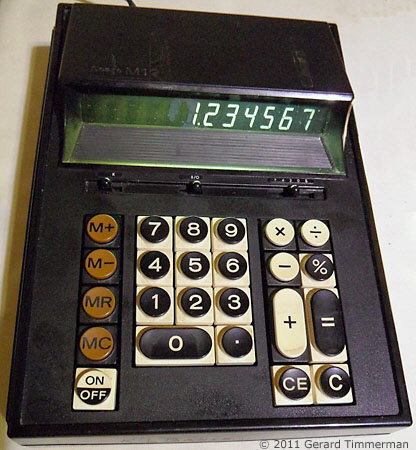
Sears M12
Distinctive features: One of the first calculators with a Liquid Crystal Display (LCD), using a DSM (Dynamic Scattering Mode) LCD.
Technical details: Display is 12 digits, reflective LCD (Liquid Crystal Display), which is illuminated by a fluorescent tube. In this example the left-hand half of the display is damaged and not working.
4 function, %.
The circuit board in this model carries 4 Large-scale integrated circuits manufactured by Rockwell (three type 10417PB and a 15361PB), and in the machine illustrated are date coded to mid-1973.
Sears, Roebuck & CO., Chicago, Ill, U.S.A.
Assembled in Mexico.
Photographs kindly supplied by Gerard Timmerman.
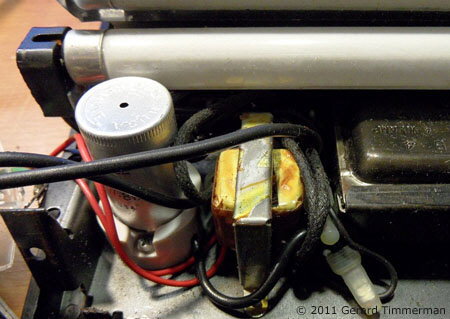
Highly unusually, the backlight is a fluorescent tube running directly off the 110V supply with a regular starter and ballast.
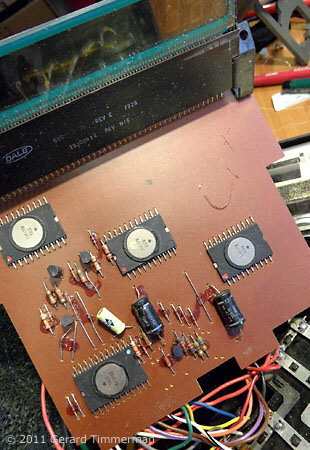
The circuit board showing the four Rockwell integrated circuits.
Rockwell manufactured these models. "Assembled in Mexico" was standard for Rockwell calculators of this period.
The journal Electronics in March 1972 reported[1]:
"North American Rockwell will begin delivering in June electronic calculators that are expected to sell to the consumer for about $100. Among the customers is Sears Roebuck
. The calculators, which will have unique features and case designs for individual customers, will use liquid crystal displays and MOS ICs manufactured by NRMEC—North American Rockwell Microelectronics
Co.
NR has contracts for more than 150,000 machines with Sears, Lloyds of California, Logic Data of Chicago, and others to be announced. And Donn L. Williams, president of NR's Electronics group, says that worldwide sales are expected to to total at least a million units a year."
Calculator models manufactured by Rockwell for other companies were the first calculators with a Liquid Crystal Display (LCD) to go on sale (see also the Lloyds Accumatic 100 hand-held model).
Due to the digits of this first generation LCD operating in a scattering mode a filament lamp is used to illuminate the display from above it. The lamp has a high current consumption which negates the main advantage of the low power consumption of the LCD. Other slightly later models (eg. Sharp EL-8001) used a reflective type LCD where a hood over the display with a diffusing window illuminates the numbers of the display.
The introduction of LCDs in calculators was not smooth. There was much debate about the life expectancy of the Liquid Crystal compounds used in these displays. Two of the examples here have damaged displays though one example still worked perfectly after 30 years. High temperature storage, especially, is to be avoided with these displays. There also appear to have been manufacturing problems, and it was to be 3 or 4 years before LCD technology had improved and cost dropped for it to start becoming the dominant display of calculators.
See the article "Liquid Crystal Display (LCD) Calculators" on this site for information about other early LCD calculators.
Excellent Youtube videos produced by Michiel de Boer that graphically explain these Liquid Crystal Displays are:
- "The DSM LCD (like) you've never seen" - https://www.youtube.com/watch?v=eGQQWIbD-nM
- "LCD Explained (and more)" - https://www.youtube.com/watch?v=J6W1jYoa1HM
References:
Electronic Desk
Calculators
Vintage Calculators
Text & photographs copyright, except where stated otherwise, © Nigel Tout 2000-2026.